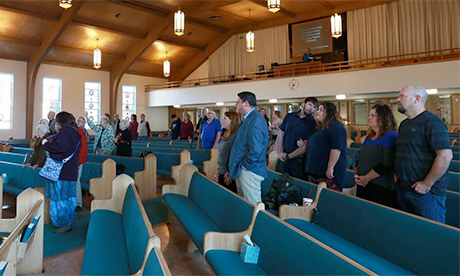As a stir-crazy nation slowly emerges from the Covid-19 pandemic, debates about what our “new normal” will be like are intensifying.
- Will the shock of the lockdown bring a transformative moment of social solidarity? Or tear us apart in tribal strife?
- Will there be a baby boom or baby bust? More marriages or more divorces?
- Capitalism is over, some say, while others promise the rich will only get richer.
The future of our national religious life is also the subject of growing speculation, with the sunny-side-up view arguing that we are primed for a new “Great Awakening” of the sort that have periodically transformed American culture.
This revival will be spurred, the thinking goes, by a flood of Americans who ache for a return to communal worship that has been denied them for months.
They will be joined by newcomers who, chastened by this national memento mori, discover or rediscover the balm of faith.
“Could a plague of biblical proportions be America’s best hope for religious revival?” Robert Nicholson wrote in the Wall Street Journal.
“[T]here is reason to think so.” Shadi Hamid of the Brookings Institution had the same question: “It could also go the other way,” he tweeted, “but my instinct is to think that a great awakening is now *more* likely, at least in America, by 2050.”
To many, the prospect of a resurgence in religious observance is an enticing vision, because faith communities can be anchors of social solidarity, which has been steadily eroding for decades.
The data and history tell a different story, however, and, much like the economic outlook, the forecast for religion looks more like recession than resurrection.
Historians of early Christianity note that Jesus’ disciples jump-started the church’s growth by remaining with the sick during various outbreaks that coursed through the Roman Empire, from the Antonine Plague in the second century to the Plague of Cyprian in the third.
“Indeed, the impact of Christian mercy was so evident that in the fourth century when the emperor Julian attempted to restore paganism, he exhorted the pagan priesthood to compete with the Christian charities,” sociologist Rodney Stark wrote in The Triumph of Christianity.
The best case study for the Religious Comfort Hypothesis was the February 2011 earthquake that devastated Christchurch in New Zealand, by any measure a highly secularized country.
Yet the world is far different today.
The martyrs of Covid-19 are the doctors and nurses and essential workers who keep hospitals running, grocery shelves stocked, mass transit running, and sanitation crews and truck lines operating—the people Pope Francis calls “the saints next door.”
This time, owing to the way the novel coronavirus spreads, pastors serve best by remaining isolated from the people they were ordained to serve while hospital chaplains and other ministries serve the sick and dying.
The most visible religious icons of this pandemic are the few but vocal self-styled divines who insist on holding in-person services to make a grandstand on religious liberty or to show the secular world how tough they are.
At best, they are preaching to the converted, the regular churchgoers, mainly white evangelicals and Catholics, who have already been trending conservative in recent decades.
But their unholy foolishness is not the kind of witness that will stir souls to greater observance, and surveys show their numbers are shrinking.
Such congregations have been more effective dispersal mechanisms for the virus than for the faith.
Another argument for a post-pandemic revival rests with what is known as “existential security theory,” or the “Religious Comfort Hypothesis”—social scientists’ way of saying there are no atheists in foxholes.
Existential security theory was popularized by political scientists Pippa Norris and Ronald Inglehart in a 2004 study that sought to explain why the global population is getting more religious, not more secular, as conventional wisdom suggests.
Their explanation: The continuing experience of death and grief causes people to turn to religion as a balm.
Richer and more secure societies, the argument goes, have less “need” for religion because faith in progress and policies—and, in the United States, a belief in our protected status as blessed by the Almighty—stands in for the comforts of traditional religion.
But what happens when natural disasters and societal breakdowns happen in industrialized countries like the U.S.?
The best case study for the Religious Comfort Hypothesis was the February 2011 earthquake that devastated Christchurch in New Zealand, by any measure a highly secularized country.
It was the worst disaster in the country in 80 years. One-third of the city’s buildings were destroyed and 185 people were killed in an urban region of fewer than 400,000.
Chris Sibley, a psychology professor at the University of Auckland, and Joseph Bulbulia, a religious studies professor there, were in the midst of a longitudinal study of the values of New Zealanders when the earthquake struck.
They had data from before the disaster to compare with behaviours immediately afterwards.
“Consistent with the Religious Comfort Hypothesis, religious faith increased among the earthquake-affected, despite an overall decline in religious faith elsewhere,” they concluded.
At first blush, this seems to be true for the coronavirus response, as well.
A study just published by Danish economics professor Jeanet Sinding Bentzen, a leading researcher on the religious coping phenomenon, argues that based on rates of Google searches for prayer, “the demand for religion has risen dramatically since the onset of the pandemic.”
“A pandemic this size potentially changes our societies for years to come, especially if it impacts our deep-rooted values and beliefs. I find that the COVID-19 crisis impacts one of the deepest rooted of human behaviours: religion,” Bentzen tweeted. Continue reading
Additional readingNews category: Analysis and Comment.




